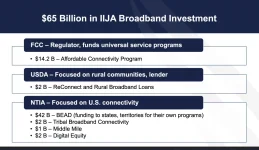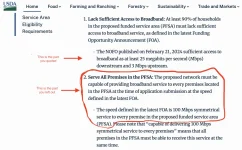A few thoughts:
1) It wouldn't be for "20 people", it would be for a household.
Yes, because businesses and other organizations with more than 20 people don't exist in rural areas.



2) 220 mbps is PLEANTY of bandwidth for 20 people. You don't need 2 gbps, up or down.
You do, if you have more than 20 people in your business.
3) the Rural Broadband project only requires 20 mbps down and 3 up.
LOL
First of all, that's not the entire "Rural Broadband Project," not even close. It's the
USDA's "ReConnect Program." That is only a small part of the total effort. $65 billion was allocated, and only $2 billion goes to the ReConnect Program:

Most of the funding, as you can see, went to the NTIA Broadband Equity, Access, And Deployment (BEAD) Program. States basically wrote their own proposals. Or perhaps you think that a federal mandate to buy just one company's product is somehow better than letting states determine what's best for their constituents?

Second: Surprise! Your blatant attempt to quote mine is an Epic Fail. The USDA most certainly did NOT say that the goal is to get everyone to a minimum of 25 up and 3 down -- what you highly selectively quoted is
the official definition of an underserved area. The goal is symmetrical 100mbps. Here's some of the stuff you "conveniently" left out:

4) Nobody, and I mean nobody is running fiber to rural homes.



Surprise! This isn't exclusively about "rural homes," not by a long shot. For example, the ReConnect Program which you quote-mined is eligible for:
• Corporations
• Limited Liability Companies and Limited Liability Partnerships
• Cooperatives or mutual organizations
• States or local governments, including any agency, subdivision, instrumentality of political subdivision thereof
• A territory or possession of the United States
•An Indian Tribe, as defined in Section 4 of the Indian Self-Determination and Education Assistance Act (25 U.S.C. §450b)
By the way, all those applicants? Yeah, the government needs to make sure they're using the grant money properly. That requires... wait for it... a whole Reporting & Compliance system to verify the grants. Notice how something that seems so simple (giving a business a grant to install a terrestrial Internet line) requires all sorts of bureaucracy, in order to meet goals such as "reducing fraud"?
Starlink can beat the Rural Broadband contract requirements by a factor of 9 today....
Please.
Aside from the fact that you blatantly ignored the program's
actual goals, the only reason you're saying "Starlink" is because Musk owns it, and you think mentioning it somehow pwns teh libz.
And again, Starlink simply isn't good enough to meet the program's goals. BIPARTISAN goals, by the way.


